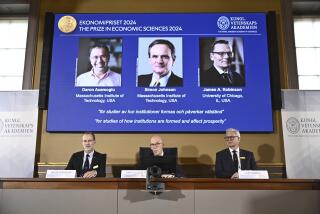Economist Urged Using Wealth for Social Needs
John Kenneth Galbraith, a longtime professor of economics whose bestselling books challenged the idea that a surging economy was a measure of social excellence and instead urged government to divert more of the nationâs wealth to social needs, died Saturday. He was 97.
Galbraith died of natural causes at Mount Auburn Hospital in Cambridge, Mass., according to his son Alan.
Galbraithâs fame was cemented with the 1958 publication of âThe Affluent Society,â a title that soon became a watchword, and âThe New Industrial State,â a follow-up work published in 1967. When his books were published, America was without peer as an economic power, and Galbraith, an esteemed Harvard University professor, argued that the free-market economy was a myth and that the 1,000 largest American corporations dominated both the nationâs economy and its social life.
Giant corporations essentially operated free of competition, he said, often turning out frivolous goods for an increasingly consumer-minded society, while the capitalistic economy ignored more pressing social needs. âAmericans still have an extraordinary capacity to ignore poverty,â Galbraith told an interviewer in 1983. âI am struck by our superb capacity to manufacture consumer gadgetry, including electronic games, versus our capacity to produce schools.â
He pleaded for a change in public values in favor of supporting everything from the arts to better housing for the poor, and he favored intervention by the federal government to rein in corporate power. He believed that more tax money should be used to address social needs, such as improving education and protecting the environment.
âThe Affluent Societyâ was translated into a dozen languages and sold more than 1 million copies. It also helped influence a surge of federal spending on social programs in the 1960s, in what came to be known as the Great Society during Lyndon B. Johnsonâs administration. Forbes magazine, no fan of Galbraithâs liberal ways, called him âoverbearing, witty, acid-pennedâ but conceded that he was âAmericaâs favorite economist.â
Galbraith was a man of varied talents. He also worked as a journalist and held various jobs in four Democratic presidential administrations, including deputy administrator of the Office of Price Administration for President Roosevelt during World War II and ambassador to India under President Kennedy.
Galbraith wrote more than 30 books, including fiction and a volume on his Scottish family history, but his celebrity was earned from his works in politics and economics. His books, which include âAmbassadorâs Journalâ and âThe Great Crash, 1929,â were marked by a caustic wit and elegant prose that turned arcane economic theories into readily understood ideas.
Galbraith was a Keynesian, inspired by British economist John Maynard Keynes, whose theories gained wide currency during the Great Depression. Keynes argued that governments could smooth out the boom and bust cycles of capitalistic economies by spending more to prime the economy and create jobs during bad times and raising taxes in boom times to build budget surpluses and check inflation.
Keynesian theory lost its gloss after the 1970s, when oil prices jumped and inflation jumped too, despite frantic governmental efforts to keep it under control. Toward the end of his life, some of Galbraithâs theories were discredited by the marketplace, notably his idea that major corporations basically need not worry about competition and that small businesses and entrepreneurs were imperiled by the long shadows of giant corporations.
By 2002, Japanese car companies controlled 28% of the American passenger vehicle market, at the expense of General Motors, Ford and Chrysler, and the economic recovery of the 1980s and â90s was credited in large part to the steady growth of small companies.
Microsoft Corp., for instance, was founded as a tiny enterprise in 1975 by Bill Gates and Paul Allen. And their business grew from a mere supplier for mighty IBM to the most valuable company on the planet as Microsoftâs computer software became more lucrative than the computer boxes that contained it.
Not surprisingly, Galbraith attracted many critics.
Columnist Donald Lambro wrote in The Times in 1987: âPerhaps no single set of predictions and observations in modern economics has been so misguidedly wrong as the ones Galbraith set forth in a body of work noted for its myopia over corporate bigness.â
Galbraith retired from Harvard in 1975 but was still widely sought out despite his theories having fallen somewhat from favor. Economist Adam Smith wrote, âMr. Galbraith may sometimes be hard to take, but he is still worth taking.â
The economist was born on a modest cattle farm in Ontario, Canada, in 1908. His father was a teacher and county official, and Galbraith grew up with a keen interest in agriculture.
He earned a doctorate in agricultural economics from UC Berkeley in 1934 and became a naturalized U.S. citizen in 1937.
In his memoirs, âA Life in Our Times,â Galbraith wrote that âagricultural economics left me with the strong feeling that social science should be tested by its usefulness.â
So he, along with many other Keynesian economists, went to work for Rooseveltâs New Deal administration, trying to use economic theories as tools to fine-tune the economy.
In 1941 Galbraith was appointed deputy administrator of the Office of Price Administration in charge of fixing civilian prices on essential supplies -- including rubber, gasoline and food -- that were rationed to help support the war effort. After a shaky start, the price controls worked well.
Galbraith joined Fortune magazine in 1943 and worked as a writer and editor under the tutelage of publisher Henry Luce.
As a journalist, Galbraith said, he was exposed to âthe modern large corporation as a primary economic and social force.â In 1948 he returned to Harvard, where he had once been an instructor, to teach and write.
Galbraithâs influence reached its zenith after âThe Affluent Societyâ was published. The bookâs most widely quoted passage was a scathing attack on middle-class consumption:
âThe family which takes its mauve and cerise, air-conditioned, power-steered and power-braked car out for a tour passes through cities that are badly paved, made hideous by litter.... They ... spend the night at a park which is a menace to public health and morals. Just before dozing off on an air-mattress, beneath a nylon tent, amid the stench of decaying refuse, they may reflect vaguely on the curious unevenness of their blessings. Is this, indeed, the American genius?â
Time magazine, published by Luce, dismissed the book as a âvague essay with the air of worried dinner-table conversation.â
Yet the work caught the attention of John F. Kennedy. Galbraith had already served as a speechwriter for twice-defeated presidential candidate Adlai E. Stevenson. He wrote speeches for Kennedy as well and campaigned for his election as president in 1960.
Galbraith also wrote a draft of Kennedyâs inaugural address, but little of what he composed survived to the final version.
The economist had met Kennedy when the future president was a student at Harvard during Galbraithâs stint as an instructor there in the 1930s. At the time Galbraith preferred the eldest Kennedy brother, Joseph Jr. (who was killed in World War II).
In his memoirs, Galbraith wrote that the young John Kennedy he knew âwas handsome but, unlike Joe, was gregarious, given to varied amusements, much devoted to social life and affectionately and diversely to women. One did not cultivate such students.â
Kennedy cultivated Galbraith, however, offering to name him as head of his Council of Economic Advisors. Galbraith turned Kennedy down, accepting instead the ambassadorship to India. Galbraith later wrote about his two years there in âAmbassadorâs Journal,â which became another bestseller in 1969.
With characteristic wit, he detailed the behind-the-scenes nature of diplomacy, including an account of then-Vice President Johnsonâs tour of India and their meeting with Prime Minister Jawaharlal Nehru.
âThe prime minister and vice president spoke rather formally on education which they favored, poverty which they opposed, freedom which they endorsed, peace which they wanted and the Third Five-Year Plan which they praised,â he wrote. âThe rest of us listened with respect and drank tea.... Then with some pomp we called on the president [of India]. India is underdeveloped in everything but photography, and each of these stops was fully recorded.â
For many, Galbraith -- 6 feet 8 inches -- literally and figuratively towered over his contemporaries. But more than three dozen Americans have won the Nobel Prize for Economics since 1969, and Galbraith was not among them.
He outlived most of his contemporaries and remained active writing about them. His memoir, âName-Dropping: From FDR On,â published when he was 91, contains anecdotes about political figures he knew, including Eleanor Roosevelt, âwho, but for the accident of history and the prevailing constraints of gender, could have been president in her own right.â
Throughout his life, Galbraith remained a wary observer of Wall Street.
After the October 1987 stock market plunge, when the Dow Jones industrial average tumbled 22% in a single day, Galbraith drew comparisons to the epic crash of 1929.
Avarice on the part of myopic investors, he said, was a recurring theme. âIâm inclined to think that fools and their money will always be separated,â he said.
In addition to Alan, his survivors include his wife Catherine (they married in 1937) and two other sons, Peter and James.
More to Read
Sign up for Essential California
The most important California stories and recommendations in your inbox every morning.
You may occasionally receive promotional content from the Los Angeles Times.











